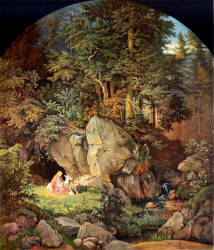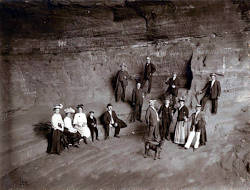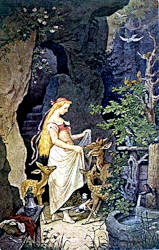Genovevahöhle
Kuttbachhöhle
Useful Information


| Location: |
Kordel.
3.75 km (as the crow flies) south of Kordel. (49.8064592, 6.6466568) |
| Open: |
no restrictions. [2023] |
| Fee: |
free. [2023] |
| Classification: |
 erosional cave erosional cave
 Cave House Cave House
 Genoveva Caves Genoveva Caves
|
| Light: | not necessary/bring torch |
| Dimension: | L=15 m, W=15 m, H=10m |
| Guided tours: | self guided |
| Photography: | allowed |
| Accessibility: | no |
| Bibliography: | |
| Address: |
Deutsch-Luxemburgische Tourist-Information, Moselstr. 1, 54308 Langsur-Wasserbilligerbrück, Tel: +49-6501-602666.
E-mail: |
| As far as we know this information was accurate when it was published (see years in brackets), but may have changed since then. Please check rates and details directly with the companies in question if you need more recent info. |
|
History
| 1910 | Steps to the cave hewn out of the rock by the Kordel local group of the Eifelverein. |
Description


The Genovevahöhle (Genevieve cave) is only one of several with the same name. But the tendency to name caves after Genevieve is rather young, probably the names are a result of German Romanticism and the opera of the same name by Robert Schumann. Until the id 19th century the inhabitants of nearby Kordel called the cave simply Kutbachhöhle, after the river below. This cave was renamed by a bureaucrat form Mayen who was posted to Pfalzel. He discovered the cave on a walk and remembered the legend of Genoveva.
Genoveva was the daughter of the Duke of Brabant, she is also called Genoveva of Brabant.
She lived around 750 AD and was the wife of Palatine Siegfried of Trier.
One day Siegfried went to fight in a war.
On his return his butler Golo accused Genoveva of adultery.
Siegfried commands his vassals to kill her, but they help her to flee.
While roaming the forest she discovers the small cave and stays here.
Pregnant from her husband, she comes down in the cave with her son Schmerzensreich (painful).
Together they live in the cave for many years.
Six years later Siegfried learns about the innocence of Genoveva.
He searches her and brings her back.
Golo is quadrisected for his betrayal.
Legend after Capucine monk Martin von Cochem around 1640
The legend of Genoveva is most likely fictitious, there are no historic documents. The original version of the legend is attributed to the cappucine monk Martin von Cochem who is said to have written it around 1640. However, there are other sources telling the legend was from 1687. Later the legend became part of a collection of legends, and also the brothers Grimm included the legend into the collection Deutsche Sagen (1816) after a source from 1612. In 1834 Ludwig Tieck wrote Genoveva and in 1841 Friedrich Hebbel wrote Genoveva. Finally Robert Schumann created his only opera (Genoveva, 1850) based on this two dramas. This made this story rather famous, and there were no doubts about its authenticity.
This cave is a natural cave in sandstone, formed by the erosion of the Kyll river. Its form depends on the structure of the rock, as the water eroded the softer layers much faster than the harder layers. The Kyll was cutting through the old landscape forming a steep valley. As the river flew at the level of the cave it was washed out by the flowing water. But the river continued to cut in and today it flows much deeper.
The cave was used as a shelter since the Palaeolithic (between 16,000 and 12,000 BC). The visitors were hunters or herdsmen. The cave was never used continually, but it was visited over millennia. In historic times it was used by hermits and refugees, who were looking for shelter. The result of this use are numerous artificial alterations in the cave, like steps and benches along the wall which were cut into the rock. But beneath the traces in the rock, there were no archaeological remains found in this cave.
 Search DuckDuckGo for "Genovevahöhle Kordel"
Search DuckDuckGo for "Genovevahöhle Kordel" Google Earth Placemark
Google Earth Placemark Genovevahöhle
Genovevahöhle  - Wikipedia (visited: 13-MAR-2023)
- Wikipedia (visited: 13-MAR-2023) Genovevahöhle (visited: 13-MAR-2023)
Genovevahöhle (visited: 13-MAR-2023) Index
Index Hierarchical
Hierarchical Countries
Countries Maps
Maps